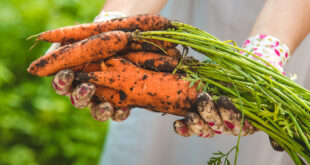Most gardeners will say they never have enough compost, but it tuns out compost quality, not quantity is what really counts. This is because the benefit of compost is not so much that it feeds the soil with important nutrients, but that it introduces helpful microscopic organisms into our garden. These tiny organisms are known as mycorrhizae, and they belong in the fungus family.
What do mycorrhizae look like?
As we know from gathering mushrooms, there are two parts to a fungus – the fruiting body above the soil (the mushroom), and the soft root-like structure beneath the ground (the hyphae). If you’ve ever lifted up a fork of well-decayed compost, you’ll have spotted the hyphae as clumping masses of white threads which often seem to be holding the soil together. When we put well-made compost onto our gardens, we are introducing these beneficial fungi into the soil where they will continue to grow and develop. So just how do mycorrhizae survive in the soil, and more importantly, how do they help our gardens grow better?
How do mycorrhizae survive in our soil?
Plants make food from the sun. When they make more than they need to build leaves, stems, and branches, they send the extra food down into their roots. It’s in this root zone that the mycorrhizae live. Because mycorrhizae live in the dark, they can’t make food for themselves and have developed ways to use the extra plant food which comes their way.
How to mycorrhizae help our plants grow better?
Plants have well developed root systems, but there’s a limit to how far these roots will grow. The hyphae of mycorrhizal fungi, on the other hand, can grow much, much further, searching out nutrients well beyond the reach of the plant. What’s more, in order to make use of the food stored in a plant’s roots, the mycorrhizae have to trade their nutrients for it. It’s a give and take situation that helps both plants and mycorrhizae to survive. That’s not all – because mycorrhizae can also help plants communicate with each other!
How do mycorrhizae help plants communicate?
Plant scientists have known for a long time plants ‘talk’ to each other. However, until relatively recently, they didn’t know how. Now, it turns out that mycorrhizae play a part in this strange phenomenon.
Mycorrhizae don’t just grow in and around and out from a plant’s roots, their hyphae actually link up with each other in massive underground ‘highways’. It’s these ‘highways’ that are used to carry important warnings from one plant to another.
Using broadbeans, scientists discovered when one bean plant in a patch is infested with aphids, it sends out a warning to its neighbours. The warning travels underground along the hyphae highway. When the neighbouring broadbean plant receives the warning, it begins producing chemicals to help protect it from attack. In the same way, plants are also able to share some of their excess plant food with hungry neighbouring plants.
What does it all mean for gardeners
Mycorrhizae are good news for our gardens, bringing food and warnings to our plants. We can build up mycorrhizae numbers by making great compost and laying it on our gardens. We can avoid disturbing the hyphae beneath the soil by gently working in the compost rather than by vigorous digging. And we can care for our mycorrhizae by growing organically and not introducing into the garden anything (such as pesticides) which might damage them. We can also give up using herbicides around our non-edible gardens as these chemicals not only kill grass and weeds, they also damage the mycorrhizae below them. By simply being aware of the living world beneath our feet, we can help our gardens grow better and stronger.










Join the Discussion
Type out your comment here:
You must be logged in to post a comment.